The EcoFlow River Max might be the most impressive portable power station I’ve looked at so far. It has two 600W AC outlets, 100W USB power delivery and a 576Wh battery that can fast charge to 80% in around an hour – around 4 times faster than any other power station I’ve tested. And there’s an accompanying smartphone app to monitor and control the unit remotely. It even has a removable battery to make it more portable without losing any functionality.
I’ll also be looking at the accompanying EcoFlow 160W solar panel that can charge the power station outdoors.
These power stations are perfect for power cuts, camping, travel, festivals and around the house and out and about to charge all your tech.
The prices do tend to vary so please check the links down below, but they’re not cheap. So I hope this video will help you make the right choice. So let’s take a closer look.
Overview
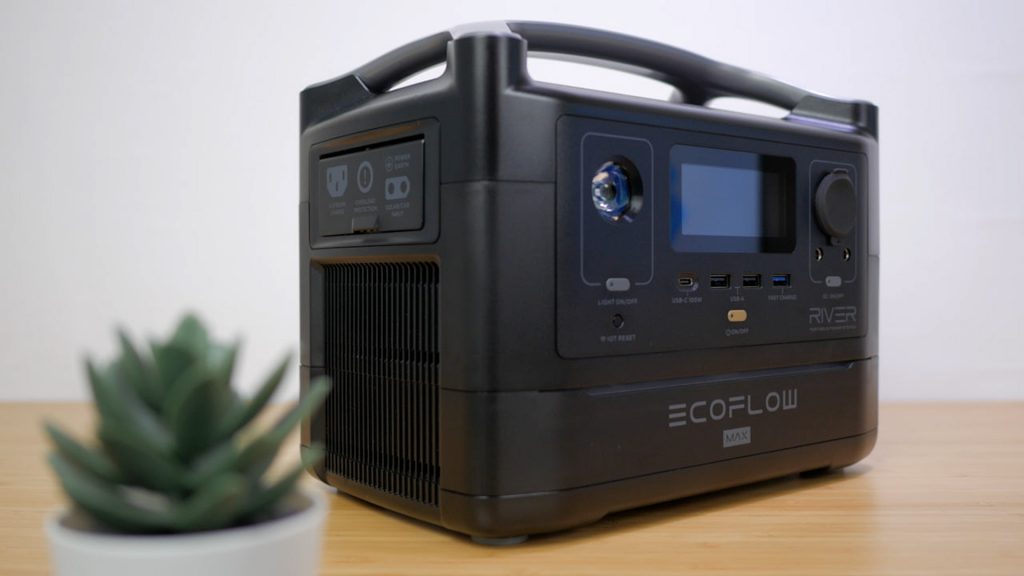
The Ecoflow River Max comes nicely packaged. Inside the box you get the power station itself, the mains charging cable, a MC4 to XT60 solar panel charging cable, a car charging cable also with an XT60 connector and a DC5521 to DC5525 lead. I’ll discuss these accessories shortly. There’s also a comprehensive and well presented user manual and a quick start guide for connecting to the smartphone app. There’s no case for the power station and there’s no included pouch for the accessories like you get with Jackerys’ chargers.
The power station has a clean modern design and feels well built, constructed of sturdy black plastic with grey trim. But like other power stations I’ve reviewed it doesn’t have any ruggedness or waterproof rating so you’ll need to keep it undercover.
The River Max weighs a pretty hefty 7.8kg and you can see its dimensions on the screen. But you do get a 576Wh Lithium Ion battery inside. To put that in context, an average laptop might have a 50Wh battery so you could charge it over 10 times from completely flat. Or the latest 16” M1 MacBook Pro with its 100Wh battery around 5 times. Alternatively you could run a typical 55” TV for up to 10 hours or a 60W mini fridge for around the same time – probably longer depending on the ambient temperature. EcoFlow’s website gives many more runtime examples depending on how you might want to use the power station.
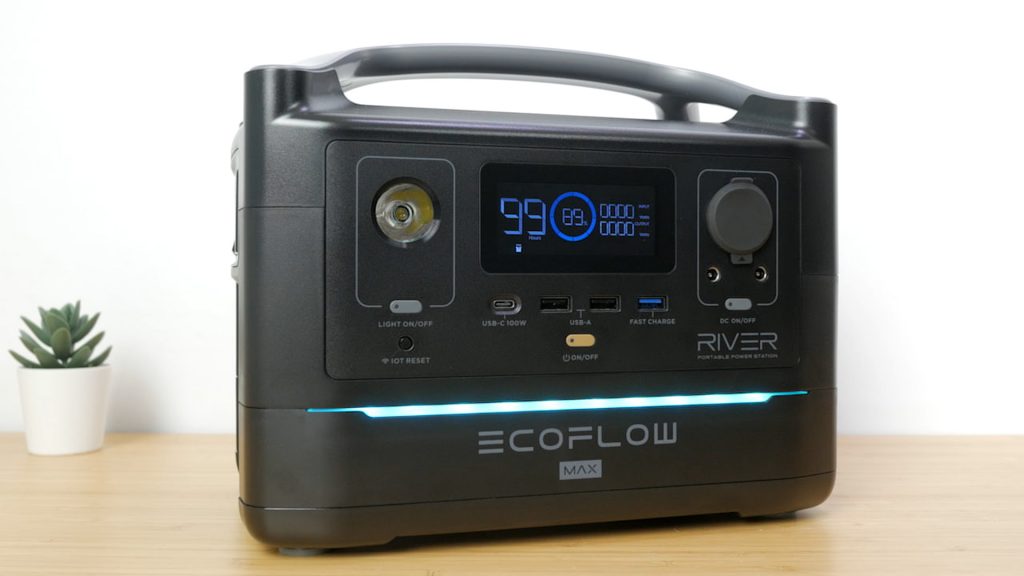
Clockwise from the top left the front of the unit has a LED torch, an 8cm two colour LCD display and below that a 100W USB-C charging port, two standard 12W USB-A charging ports and a fast charging 28W USB-A charging port. Underneath the USB ports is the main unit’s on / off button. A short press turns the power station on and turns the screen off, and on when it times out. And a long press turns it off.
Then there’s the 12V 10A DC car outlet together with two 12V 3A DC 5521 ports. These DC ports have their own power button.
The ambient light above the Ecoflow logo pulses when the display is on by default and is configurable in the app which I’ll come back to.
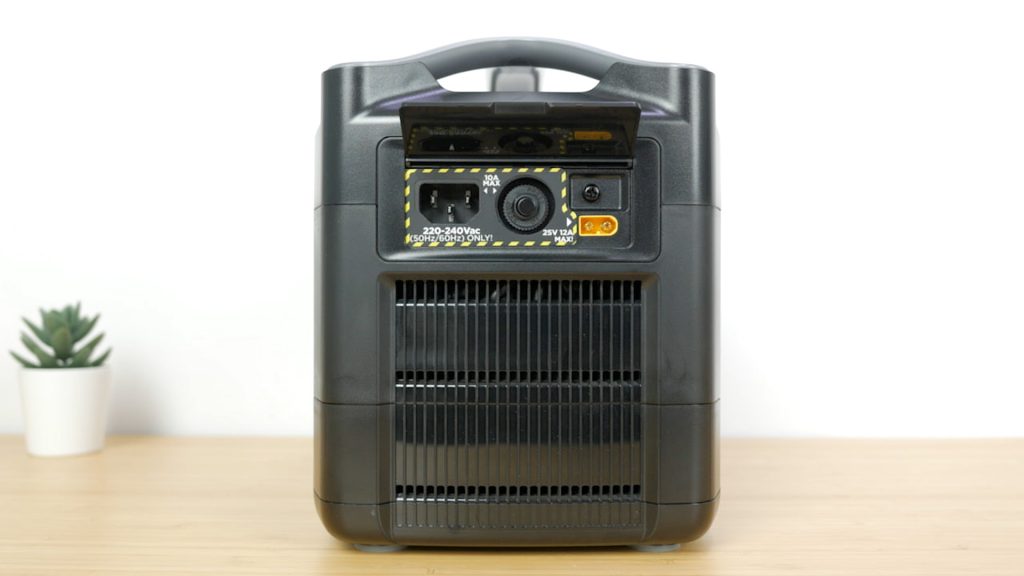
The left side of the unit has the mains charging port, the overload protection switch and the DC charging port for connecting to your car or a solar panel. The hinged door does make a slightly alarming click when you open it, but it’s survived plenty of use so far. Below these ports are cooling vents.

The right side of the unit has the cooling fan and below that two 230V AC outlets with their own power button. These outlets support 600W continuous output with a 1200W surge peak at 50Hz here in the UK and many other countries or 60Hz in America. Via a little trickery it can power some devices up to 1800W which I’ll come back to.

The bottom of the unit has four rubber feet with four bolts holding in the detachable base which I’ll come back to.
Charging
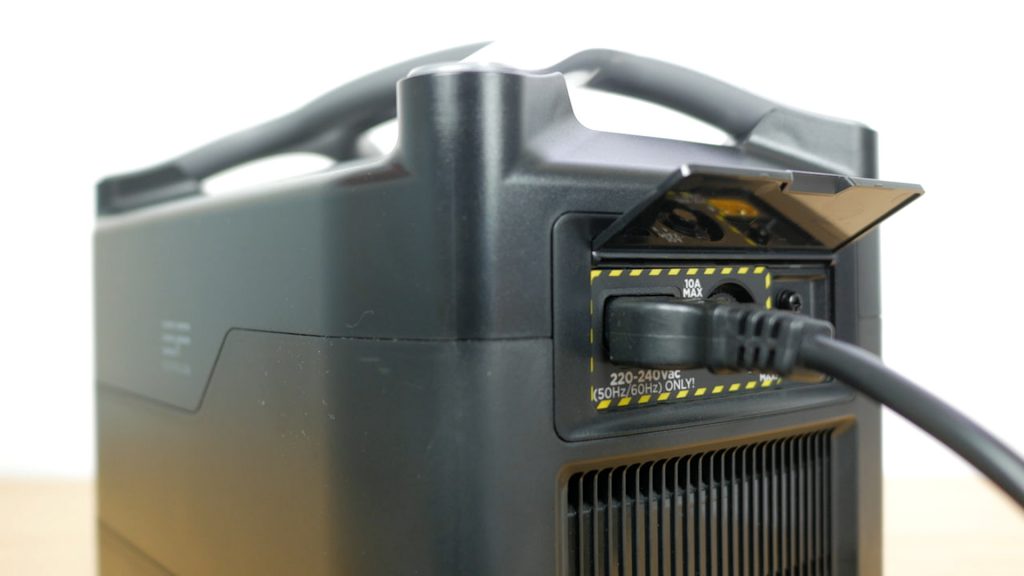
Probably the biggest selling point of this power station is just how quickly it charges, which gives it a huge advantage over other units I’ve looked at. It charges directly off mains voltage with the included ubiquitous IEC mains cable – sometimes called a kettle lead. The same cable that plugs into the back of your desktop PC. You don’t need the usual DC adapter which is one thing less to carry.

It can charge at up to 500W which according to the specs can take the battery from 0% to 80% in one hour. In my testing it took a little over that – around 75 minutes to get to 80% charge and full charge in around 2 hours which is still very impressive. But this will depend on ambient temperatures and the temperature of the unit itself.
In comparison, the Jackery Explorer 500’s 518Wh battery charges at only 85W and takes 7 hours to charge, and the Bluetti, or Poweroak in the UK, AC50S is about the same with its included charger, but does support charging at up to 120W with a beefier charger.
It’s generally advisable to charge at slower speeds to extend battery life, and fortunately you can turn off the so-called X-Stream Fast Charging in the app if you’re not in any rush.
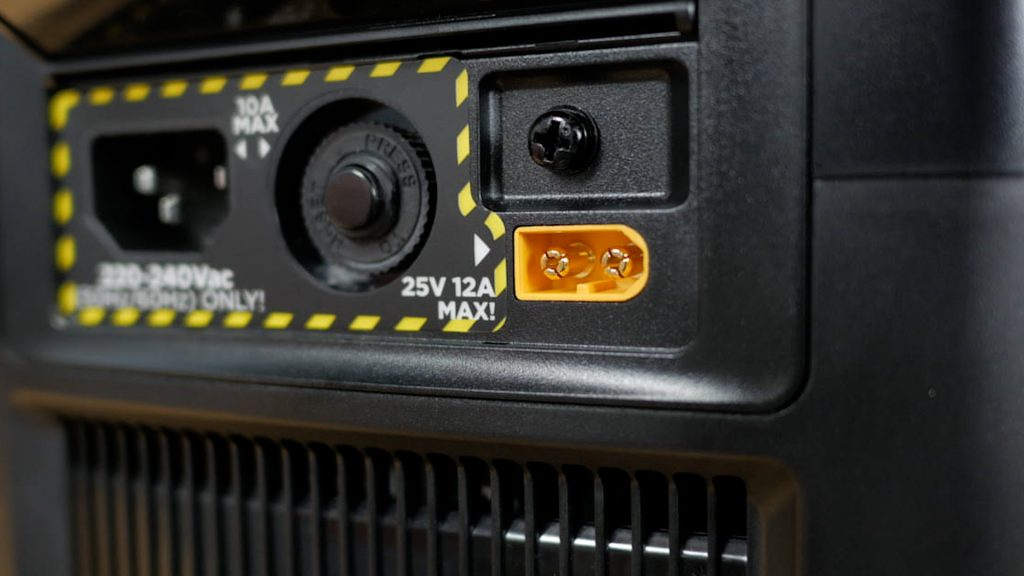
You can also charge the unit with a solar panel or via your car’s 12V output. With the included car socket plug to XT60 cable, the River Max charged at around 100W with the engine running so should take around 5 hours to charge the battery from empty.

The XT60 DC input on the power station will support solar charging at up to 200W or 12A at 10-25V. Ecoflow includes an XT60 to MC4 cable which will connect to many solar panels including their own Ecoflow 160W Solar Panel. But with the right cables and connectors you can connect most solar panels to the EcoFlow and I like that they use the popular and inexpensive XT60 connector which makes soldering up your own cables pretty straightforward.

This is a quite substantial solar panel weighing just under 7kg and comes in a grey zippered fabric pouch with a carry handle. You can see its folded dimensions on screen. The solar panel has an IP67 dust and water resistance rating unlike the power station.

The solar panel itself unfolds and then hooks onto the storage case which has one rigid side that acts as a kickstand. Unfolded it measures 157 x 68cm and around 2.4cm thick.

It doesn’t have any built-in USB charging sockets like the Jackery SolarSaga 100 – just the two MC4 male plugs.

It’s also a lot heavier than the SolarSaga 100 which weighs just 3.8kg and the Ecoflow is far more fiddly to set up. But it is a lot more powerful – 160W vs the Jackery’s 100W. I’ve been trying to test it here in the UK in winter.

But even in a short spell of sunshine, the sun was too low in the sky and I could only get around 10W. I’ll provide an update to confirm its rated output and compare it to the Jackery and also the Bluetti SP120.
With plenty of sun, you should be able to fully charge the River Max off this solar panel from completely flat in under four hours which would be very useful. Or you could get a couple of inexpensive 100W solar panels off Amazon and run them in parallel with an MC4 parallel connection cable to charge at the full 200W.
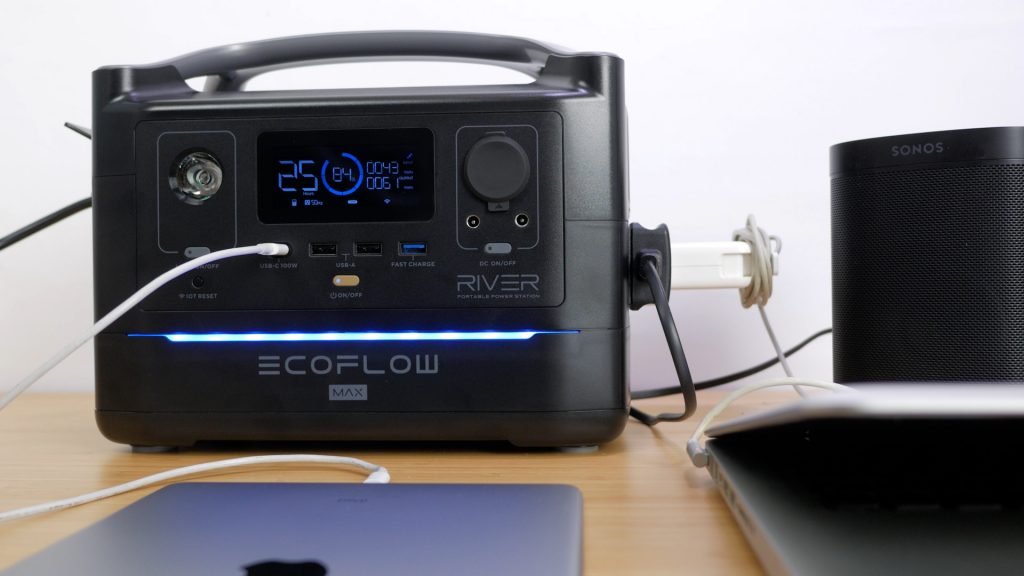
The River Max supports pass-through charging so you can still use all the power stations’ outputs whilst it’s charging from mains or DC.
Performance

The LCD display is the best I’ve seen on one of these units so far. It’s bright, clear and easy to read. And it shows everything you need to know. Like most power stations it displays power output in watts of whatever is connected and it shows input power so you know exactly what you’re putting in, which is particularly important when you’re using a solar panel which is hugely variable.
But unlike other units I’ve tested it also shows the discharge time based on current usage, and the remaining charge time depending on what you’re using to charge it.

So if for example if you’re running the River Max at its full rated 600W output, the display will show just under one hour of usage remaining. You could mentally estimate this out in your head, but it’s very convenient to see this information worked out for you. There are also icons showing which ports you have connected, warnings and even an animated cooling fan speed icon whose speed relates to the actual fan speed.
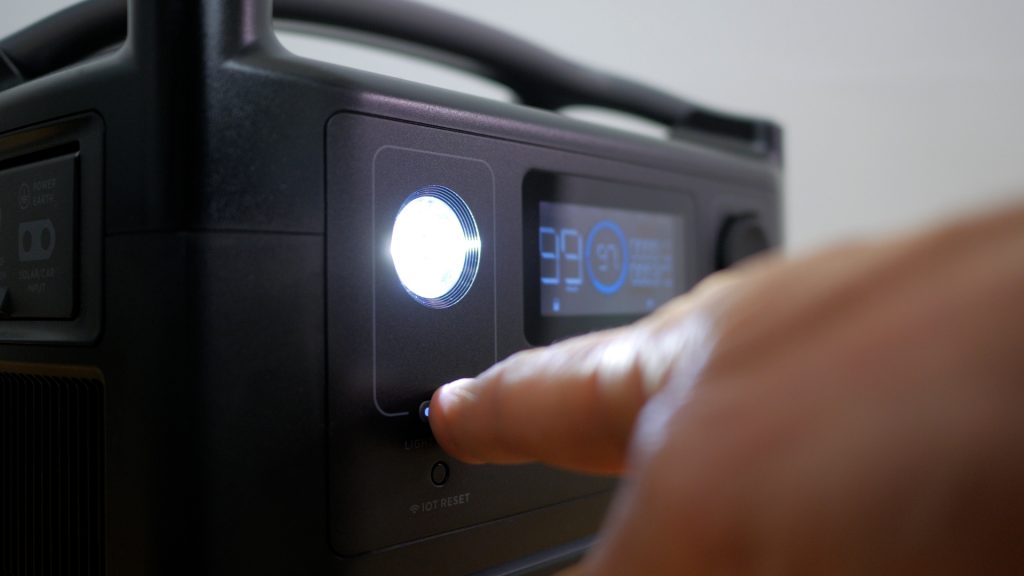
You need to turn the unit on first to use the LED torch. A single press then turns it on in low mode, a second press switches to high mode, a third press turns on flashing SOS mode. Press the button again to turn it off, or a long press turns it off from any mode.
It’s a useful 1W light in low mode and 3W light in high mode, but I’d prefer a flood light like on the Bluetti AC50S, rather than this focused beam. The unit’s much too heavy to use it in this way in most practical situations.

Moving on to the USB ports, I’m pleased to see a 100W USB-C charging port that supports Power Delivery – something I’ve been after for a while, but missing on other units I’ve tested. This lets you charge even power hungry devices with just a USB-C cable. From this Lenovo Chromebook to the latest MacBook Pros. It’d even charge the Lenovo Legion 5 gaming laptop I reviewed recently. But it’ll also fast charge the latest smartphones, or an iPad Pro and lots of other gadgets.
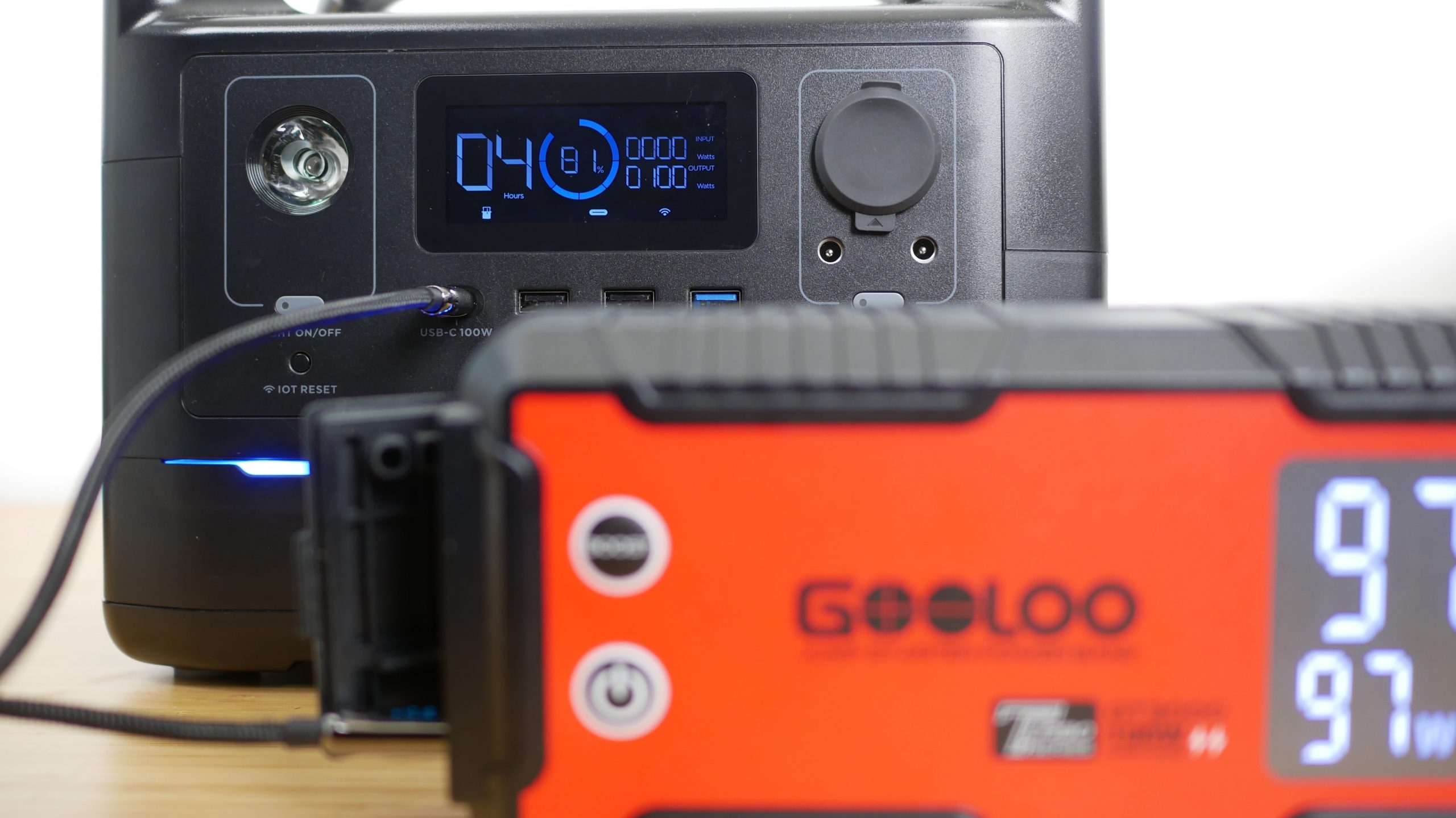
To get the full 100W (20V at 5A) you will need a USB-C cable with an E-MARK chip. I had several high quality USB-C cables that couldn’t achieve this full 100W, even though they could with other 100W chargers.

You want a cable that either mentions this E-MARK or at least says it’s capable of 100W like this one in the photo above which even has a built in power display!
The two standard 2.4A 12W USB ports don’t support any fast charging standards but the rightmost blue USB port supports Qualcomm’s Quick Charge 3.0 up to 12V and 28W.
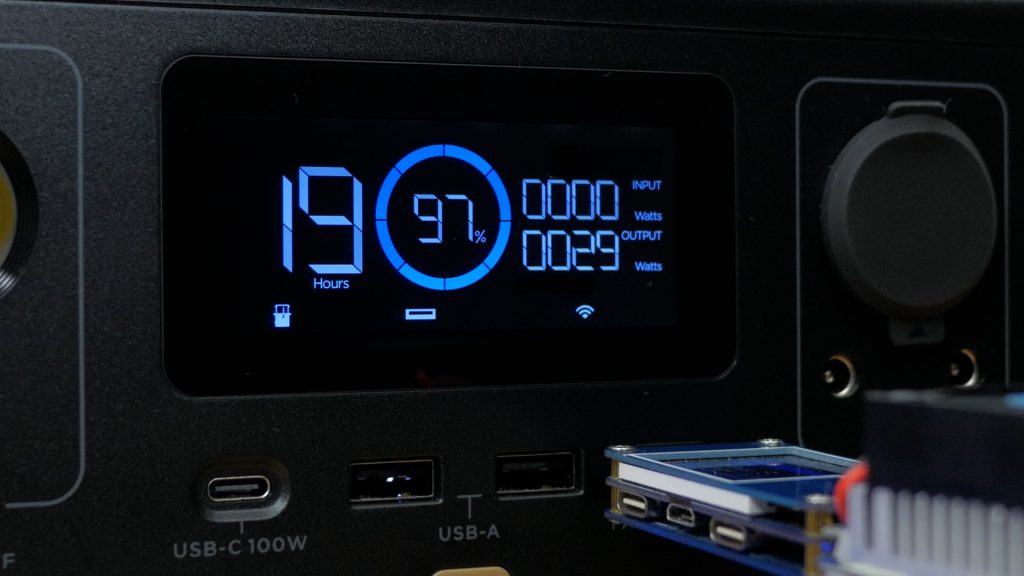
I tested all these ports to their maximum rated output and found no issues. And they can be all used simultaneously as required.

The 12V, 10A or 120W car outlet is useful for devices like car fridges. It measured 13.6V with a multimeter which confirms it’s a regulated output and will remain at this voltage as the power station loses charge.
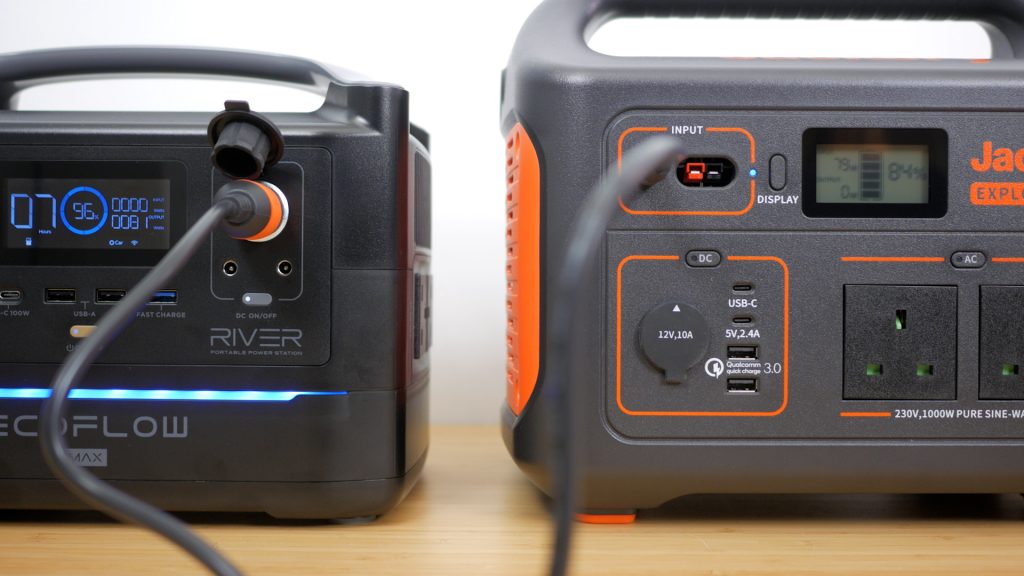
I tested it with a 12V air pump and used it to charge a Jackery Explorer 1000. I didn’t quite get the 120W output, but that’s a limit on the Jackery’s maximum input.
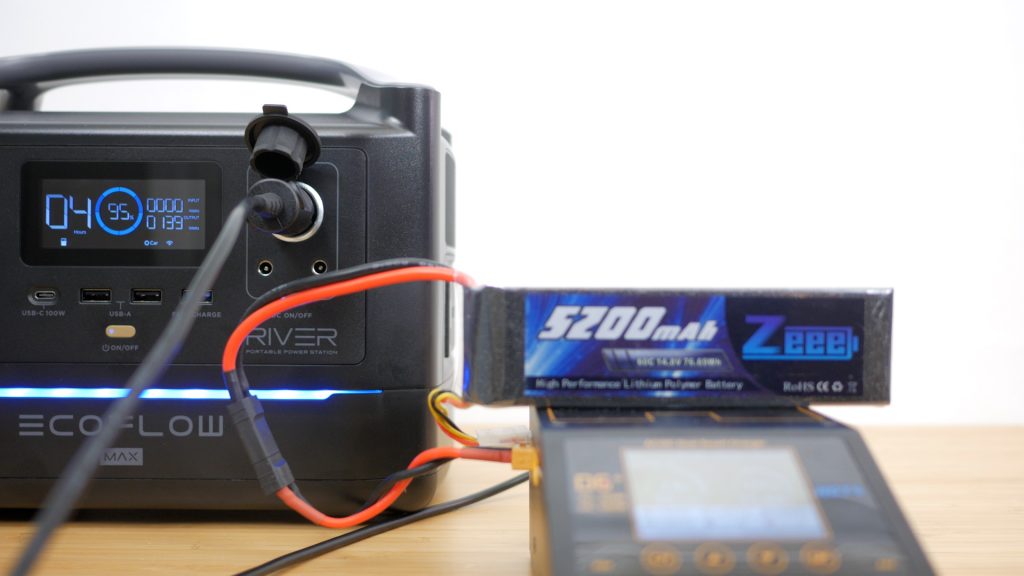
I then tried using this DC output for the DC input of my Hota LiPo charger which charges the batteries for my RC cars. I was able to charge a 4S 16V battery at 125W which displayed 140W on the EcoFlow, even more than its 120W rated output. You can pick up cheap powerful DC only LiPo chargers, so this could make a handy power supply for them.

There are also two 3A 12V DC outputs with the popular 5521 plugs with their 5.5mm external and 2.1mm internal dimensions. I’m pleased to see both of these ports are also regulated again measuring 13.6V with a multimeter. I put one of the ports to use using the supplied DC 5521 to DC 5525 cable plugged into a 12V LED lighting strip. This used around 20W according to the EcoFlow’s display. But as I’ve commented in other power station reviews I can’t find too many other uses for these ports.
The only thing really missing with the DC output of the River Max is a wireless charging pad like on the Bluetti AC50S.

The main attraction of these portable power stations are the AC outlets. There are two 600W pure sine wave AC outlets which are 220-240V in the UK and 110V in the US. I confirmed their pure sine wave output, which is important for sensitive electronics, with a graphical multimeter.

EcoFlow have put some thought into the positioning of the outlets even taking into consideration our rather oversized UK plugs.. Firstly they’re at the side of the unit so even larger plugs don’t obstruct other ports or the display. Secondly they’re rotated 90° and both sockets face each other. So two plugs, even larger ones, can generally be used at the same time. My only minor complaint is the power button to turn the AC sockets on and off is obstructed by the front plug, so is hard or impossible to access depending on the plug size, without removing the plug first.

The built-in 600W inverter is powerful enough for many items you’d want to plug into a unit like this, but as I’ve covered extensively in my other power station reviews, you need to be aware of what you’re plugging in. A cheap energy monitoring plug is a useful investment.
The Ecoflow does have an interesting feature for devices with greater power requirements. Its X-Boost technology, which is enabled by default, will let you plug in higher wattage devices up to 1800W. This is an interesting concept but you need to make sure you understand how it works.
The output of the unit still can’t exceed 600W, with a brief surge to 1200W. What the X-Boost technology actually does is to dynamically lower the output voltage of the unit so that you can still run devices with higher power requirements. If you recall the formula Power = Current x Voltage, a derivative of Ohm’s law, by lowering the voltage of the output of the power station you can still run the device, but at this lower power.

This is much clearer with an example. If I run this 1600W hair dryer off the mains, you can see the energy monitoring plug shows just over 1440W, or around 230V x 6.3A as measured by the monitoring plug.

If I plug this into the River Max with X-Boost turned off in the app, the power station shuts off with “Overload” flashing on the LCD screen and the ambient light flashing red.

When you turn X-Boost on again you’ll get a warning message which is worth reading. It’s really only advised for appliances which don’t have strict voltage requirements, typically items with heating elements like this hair dryer for example.

Now I can run the 1600W hair dryer albeit with less power but it’s still very usable. The energy monitoring plug now shows the voltage drops to 145V, pulling 4A of current which equates to around 580W.
It’s a useful feature but I’d be careful using it. I don’t think it should be on by default and I’d only recommend turning it on as needed. I’m happy plugging in this hair dryer since it’s not mine, but I’d be very careful plugging anything in with sensitive electronics and although EcoFlow suggests power tools, I wouldn’t plug in any of my power tools with X-Boost turned on. I’d stick to devices with heating elements, like this hair dryer, a sandwich maker, small fan heater or a toaster. And it’s important to note you’re still only getting 600W of output so it’ll take longer to toast your bread or dry your hair.

Still it’s a clever feature, and would be very useful in an emergency, or for camping where it could save you purchasing low powered camping specific kit.
Just as a note, I did have an issue where I left the AC on with nothing attached and came back to the power station completely drained less than 24 hours after. The AC sockets do consume some power even with nothing plugged in, so you need to try and remember to turn them off. The latest app update mentions an AC timeout setting which might fix this issue, but after updating I still don’t see this setting.
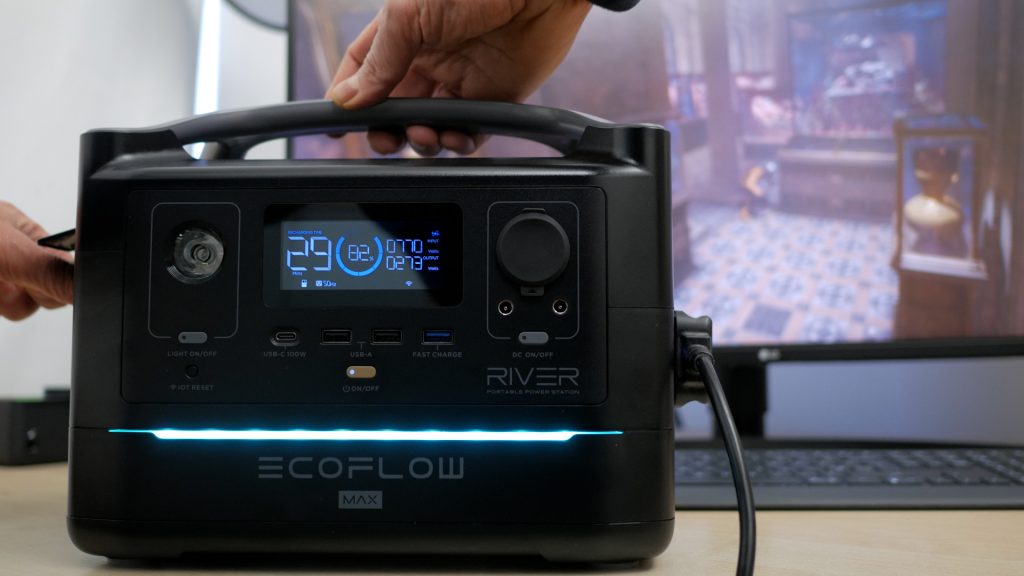
EcoFlow also advertises the River Max as an entry level UPS or uninterruptible power supply. So for example you could have your desktop computer plugged into the River Max and the River Max plugged into the mains. Your computer would bypass the power station and run off the mains, until there was a power cut where it would switch across to the power station. I tried this feature and it worked fine – my computer carried on with no interruption after I pulled the plug from the mains socket. It worked in exactly the same way as my APC ES-700 which is a dedicated UPS, except it doesn’t offer any solution for gracefully shutting down your PC like the APC unit does.
Ecoflow do state switching is only “less than 30ms” and doesn’t support professional grade 0ms switching, but I imagine it’s good enough for most people. There are lots of uses for this, not only obvious use cases like your desktop computer or household router, but I also use my UPS for 3D printing where printers can be running for hours on end and even a short power cut can ruin a print. And it has the added bonus of providing far longer battery backup than most consumer UPS’s.

I tested the claimed 576Wh capacity of the power station both at full 600W load with X-Boost on, and at around 85W with X-Boost off.

Running a 1000W fan heater with X-Boost I measured 477Wh with an energy monitoring plug. These power stations will always have conversion losses but this was a little lower than I would have hoped, working out at about 83% efficiency. And surprisingly running a 100W incandescent bulb with X-Boost off I got even less – only 448Wh which works out at 78% efficiency. When I measured the Jackery Explorer 500 which has a 518Wh battery I actually got 549Wh. The 500Wh Bluetii AC50S was very close to the EcoFlow at 463Wh.
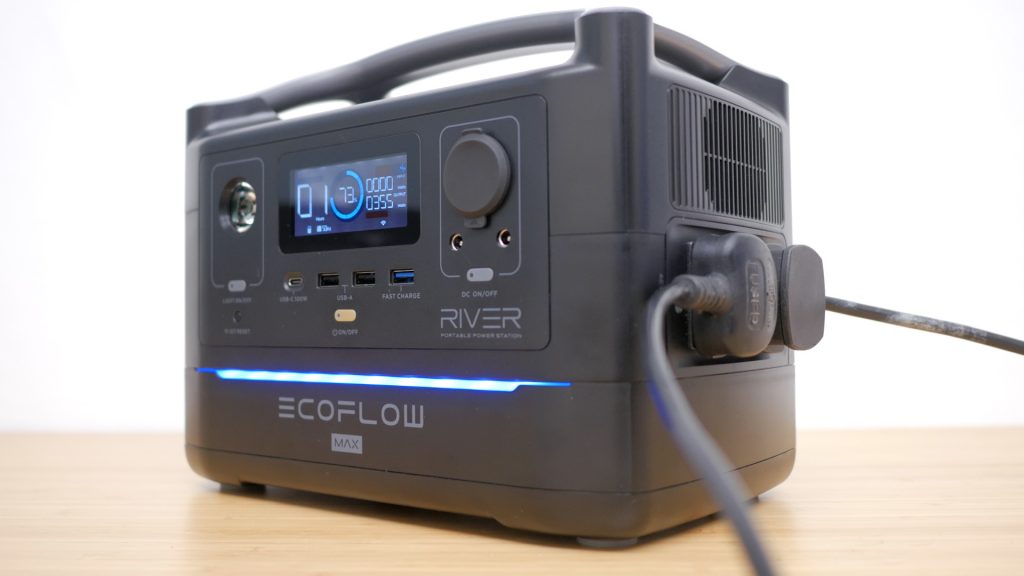
The power station is very quiet most of the time. The fan does come on as needed, but most of the time it’s barely noticeable. At full output you’ll hear it – I measured around 47dB 1 metre away – around 10dB louder than background noise.

The app which I’ll discuss shortly lets you monitor the temperature of the power station but the outside doesn’t get too hot, as you can see from the Flir thermal imaging camera.

I mentioned briefly earlier that there are 4 bolts through the power station’s feet. The River Max has a removable battery which basically turns it into the more compact Ecoflow River. You halve its capacity to 288Wh, but you still impressively retain all its other capabilities including its 600W output.

The LCD display actually shows you have this battery installed with an icon that it took me a while to identify.
Turn the unit off, remove the four bolts with the supplied Philips screwdriver and pull off the base cover. Then pull out the additional battery and reattach the base with the four included shorter bolts. You’ll need to store the longer bolts somewhere safe for when you want to attach the extra battery again. A quick release mechanism would have been nice.

You’ll notice the battery icon is now missing on the LCD display, and charging power will be halved also, but the unit will still charge in the same time. Otherwise everything is the same, but now the unit weighs 5.2kg and is more compact and transportable. You can go the other way and buy a EcoFlow River and then purchase this battery at a later date.
Unfortunately the integrated battery is not user replaceable. I really like this modular system but it would be even better if you could replace both batteries. These Lithium Ion batteries only have a 500 cycle life time and when the integrated battery eventually fails the unit won’t function, even with a brand new additional battery.
If you have multiple power stations you could connect the mains cable from one unit to the input of another unit for double the capacity. But this isn’t something I can test out.
The App
This is the first power station I’ve tested that can be controlled via an app and this gives it a few handy control and monitoring functions.

Unfortunately you do need to create an account to use the app which I feel should be optional. You’ll then need to link the River Max to the app. Tap tap the + icon, find the River Max and then press and hold the IOT reset button underneath the light button.
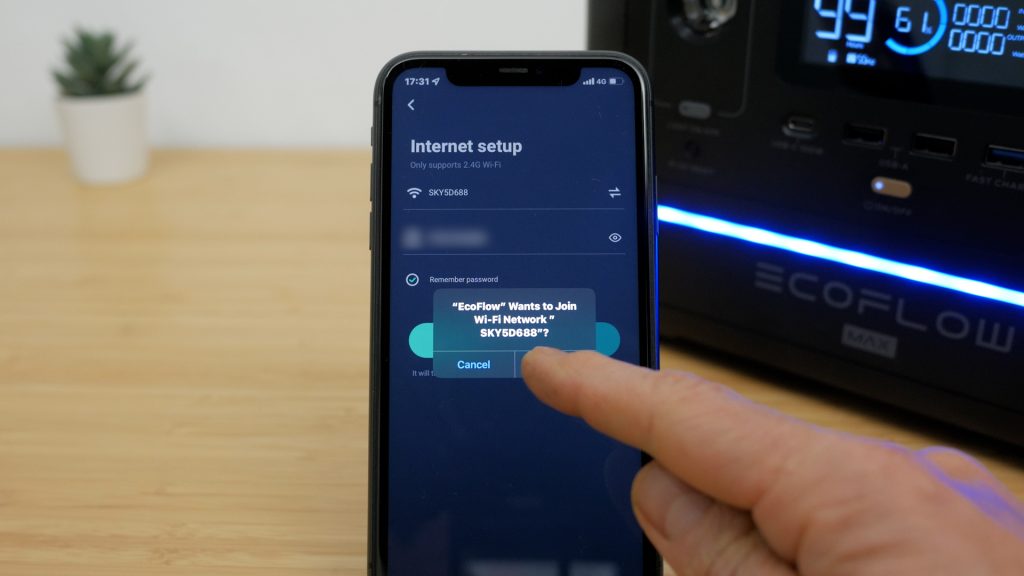
Then follow the prompts to connect your power station to your wireless network and link it to the app. This will enable you to operate the power station remotely, even over a cellular connection which might be useful.

If you’re outdoors you can connect to the unit directly although it took me a while to work out how. When you get the option to choose your wireless network, tap on “Use without Internet” below the Connect icon.
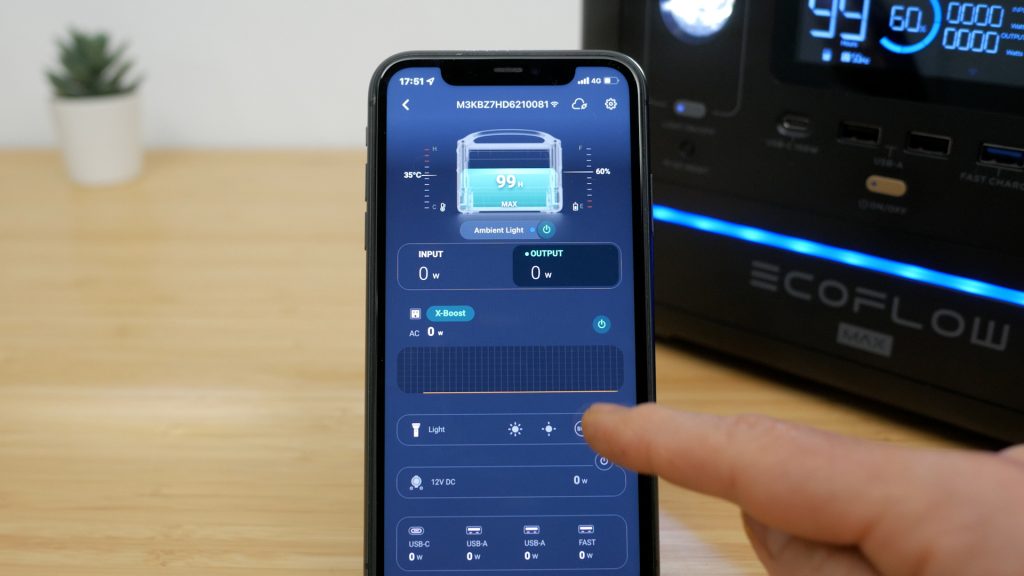
I found the unit operated more reliably and faster over a direct connection, so if you don’t need the remote functionality you could use this connection indoors also. The River Max only supports 2.4GHz WiFi so if your router is set to 5GHz only you’ll need to use this direct connection mode anyway.

You’ll probably be prompted to update the power station’s firmware which did take a while. But it’s nice to see the app and power station can easily be updated with new features and bug fixes.

The app shows much of the information on the unit’s own display, but you can also monitor the internal temperature and you can see more accurately how much usage time or charging time is remaining.
You can also control the light, DC and AC outputs and probably most importantly turn off and on X-Boost. As I alluded to earlier, I’d highly recommend downloading and connecting to the app if for nothing else, to turn off X-Boost and only turn it on as needed. I would really like an X-Boost button on the unit itself.

You can tap on the Ambient Light power button to turn this light off or click on its name to configure it. You can decide whether you want the ambient light to turn off with the screen, adjust its brightness and you can choose a lighting effect and colour.

If you tap on the Settings cog you can configure the power station setup and check for any firmware updates. Probably most usefully you can turn the beeps off.

But you can also turn on AC Slow Charging which is not a bad idea if you’re not in a rush. It will keep the power station a little cooler and quieter and most importantly extend battery life. It drops the charging power from up to 500W to around 110W.
But personally I don’t find the power station noisy and the fast charging is one of the most useful features of the River Max, so I leave it on most of the time.
There’s also an option to limit the maximum charge level. It’s not exactly clear why you would do this – perhaps again to extend battery life but the option is there. And you can limit the output from your car’s outlet and manually select between solar and car charging for the DC mode if you have any issues. There’s even a Specifications page which is useful for reminding you of the capabilities and limits of the unit.
I did have a few issues when I first connected to the app – it took a few attempts. But since then the app has worked fine. There is a noticeable delay controlling the unit from the app. For example when you tap X-Boost – it looks like nothing has happened – you need to give it up to 10 seconds to send the command to the power station. But overall the app is well designed and a useful additional way to interact with the power station.
Conclusions
This is by far the most well-rounded power station I’ve reviewed so far. The build quality is good, it has a clear informative LCD display and the accompanying app makes controlling and monitoring it even easier.
The fast charging is probably the single most impressive feature of the River Max and something I’d like to see in more power stations. And I’m pleased to finally see 100W USB power delivery, which is particularly useful for charging the latest laptops.
The 600W output from the AC outlets is probably enough for most people and the X-Boost technology is an interesting concept although it does need to be used with caution as I’ve covered.
I was a little disappointed in the measured capacity of the unit – 448Wh is a fair bit lower than the spec’d 576Wh. And it is heavier than the Jackery and Bluetti 500Wh units I looked at, although I do like the flexibility of the removable battery to bring down its size and weight. It’s a very practical solution when you have mains nearby to quickly top it up as needed. Perhaps a quick release would make it something you’d pop on and off more often.
And whilst we’re on batteries EcoFlow quotes 500 cycles for this power station which is typical for Lithium Ion batteries, and for occasional use that’s probably plenty. But for heavy users, it would be nice if the integrated battery was user replaceable or EcoFlow switched to Lithium Iron Phosphate cells which support many more charge discharge cycles.
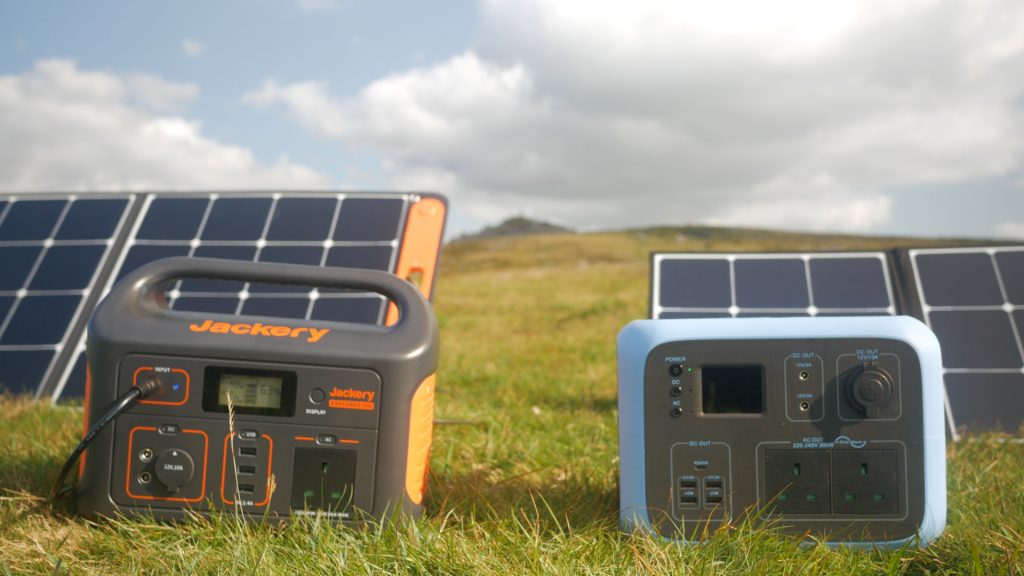
The EcoFlow 160W solar panel makes a very good accompaniment to the River Max and its 160W output is far more than other solar panels I’ve reviewed. It also has an IP67 weather resistance rating, something the River Max is lacking. It is quite pricey though and a little fiddly to set up. And the extra power output does come with additional weight. When we have some better weather I’ll do some more testing, perhaps comparing it to the Jackery SolarSaga 100 and the Bluetti SP120.
Based on my experiences so far, I’d have no trouble recommending the EcoFlow River Max to anyone after a portable power station. If you’re after something in EcoFlow’s range a little cheaper, also consider the EcoFlow River which has the same functionality as the Max just without the additional battery which you can still purchase later. If you don’t need the fast charging and 100W USB power delivery, the Jackery Explorer 500 and the Bluetti AC50S are worth considering. They’re both cheaper than the River Max and they both weigh less. The Jackery has more capacity than the EcoFlow but a little less output at 500W and the Bluetti has wireless charging but only 300W of output. I do have a full review comparing these two power stations if you want to take a look.
Don’t forget to take a look at my YouTube video at the top of the page, and subscribe to my YouTube channel where I’m releasing videos every week on the latest technology and how to get the most out of it. If you tap the bell icon when you subscribe you’ll get a notification as soon as I release a video, and there’ll be a link to my site here for the written article. YouTube is also the best place to leave a comment. I read all of them and respond to as many as I can!
EcoFlow River Max portable power station: https://amzn.to/3DShENd
EcoFlow 160W solar panel: https://amzn.to/3GCqRLi
Jackery Explorer 500 power station: https://amzn.to/33kP1vn
Jackery SolarSaga 100 solar panel: https://amzn.to/3F3MovO
Bluetti (PowerOak) AC50S 500W power station: https://amzn.to/3rYoezr
Bluetti (PowerOak) SP120 solar panel: https://amzn.to/3EUcfpY
Additional information on charger: http://uk.ecoflow.com
Leave a Reply